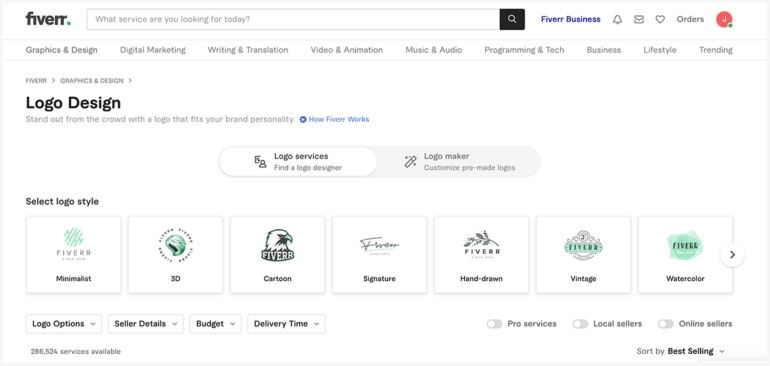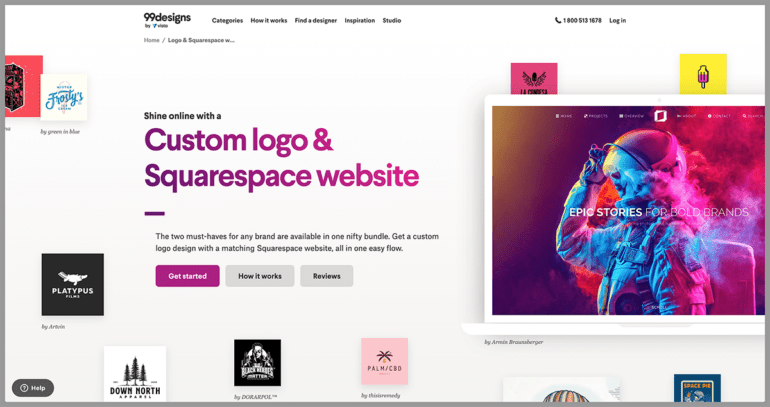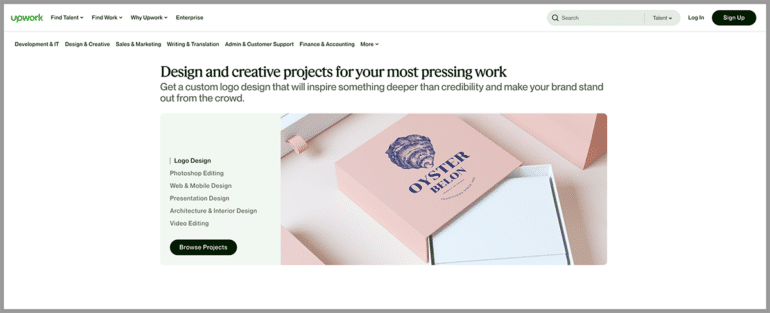Where do you start when you need a law firm logo? Check into these common options used by entrepreneurs.
Unless you were a graphic designer before law school or recently developed this skill, it’s best to outsource when your firm needs a logo. But where should you start?
How can you get a quality logo that you will like when you can’t necessarily afford to hire a design firm — while assuaging any fears of being ripped off?
Three Popular Online Options for Logo Designs
Thankfully, we live in an internet-based society with lots of options for hiring a logo designer. Here are some of the most common sources used by entrepreneurs.
Fiverr
Fiverr’s slogan is “Find the perfect freelance services for your business.” Many different types of independent contractors offer their services through this platform. Each participating graphic designer on this site sets their own rates and package offers, including the number of revisions they will provide.

On Fiverr, you can hire a graphic designer to create a logo for you for as little as $5 (hence the name) and as fast as 24 hours. I did a quick search and saw that nearly 1,400 freelance graphic designers would create your logo with those parameters — but, only 16 of them are located in the U.S., 318 of them are in Bangladesh, and 839 are in Pakistan. If you go this route because you’re on a budget or in a hurry, you will probably only get a minimalist design, possibly one from a selection of templates. Of course, there are other graphic designers on this site who offer more at a higher price point.
The upside of a service like Fiverr is you don’t have to pay until you are happy with the design. But you need to be careful to ensure that the type of file the designer will deliver (.jpg, .png, .eps) is a file type that your web designer can use to put your new law firm logo on your website. A PDF file is not good enough.
Editor’s Note: Ask for the source file. For example, if the designer creates your design in Adobe Illustrator or Photoshop, you want the original .ai file or .psd in addition to a .eps and jpg file. This way, others can open the original to update or modify it later.
99Designs
Owned by Vista (a company that may have made your business cards), 99Designs is solely a platform for hiring designers to create things like logos, business cards and websites.

There are two ways to use this platform.
Your first option is to hire someone from 99Design’s list of vetted designers. You can see the designer’s profile and portfolio in advance, and the designer sets the fee for their work.
Your second option is to have a contest. You will submit a “creative brief” about what you need designed and what fee you’ll pay for the winning design ($299 minimum). Any of 99Design’s designers can submit a logo for your consideration. This may be a good choice for a firm that doesn’t have a big budget and wants to see different styles and ideas based on the firm’s stated needs.
You get to pick your top four from the submitted designs and provide feedback. These four designers will have an opportunity to revise their designs, and then you pick the winner.
For full disclosure: When I joined Venjuris, they were rebranding the firm since they’d just selected the new name, and they used 99Designs to create their logo. I wasn’t involved in writing the creative brief, but I got to give feedback on the designs submitted. It was an easy and straightforward process.
Upwork
There are several ways you can use Upwork to hire a graphic designer to create your law firm logo.
- You can post a job on the site’s Talent Marketplace (including what you’re willing to pay) and receive proposals from previously vetted designers. The Upwork algorithm will help create a shortlist of candidates to choose from.
- You can also peruse the Upwork Project Catalog to review proposed projects and prices.
- If your project will take longer than a month, you can use the Talent Scout option to discuss your budget and goals with an Upwork recruiter. They’ll create a shortlist of talent for you to choose from.

Regardless of which option you choose, Upwork might be more cost-effective than directly hiring a graphic designer. Glancing through the site, I noticed Upwork has “graphic designer” and “logo designer” listed as separate needs, which made me wonder if the latter was merely a limited scope of offerings or spoke to the skill set of the providers. However, for each potential designer, Upwork lists their hourly rate, how many jobs they’ve performed through the site and their rating by previous clients.
I was also pleased to see that Upwork has a link to its “Modern Slavery Statement” on its homepage. I hadn’t considered that these platforms could be abused and used for slave labor, but it makes sense.
Or, You Could Hire a Graphic Designer Directly
Of course, you can go the more traditional route and hire a graphic design firm or advertising agency. Going this route will definitely take longer than Fiverr and may take longer than 99Designs and Upwork, depending on where your project falls in their queue. But you also will likely get more personalized attention. You will also pay more ($1,000 is not an unreasonable price for a logo from a professional graphic designer — and that’s on the low end). This higher price tag may come with a designer with a more advanced skill set, but there’s no guarantee.
If you have a designer you click with, you know how easy it is to work with them. I recently hired a designer to create a logo for me. I don’t speak design, but we’ve worked together previously, so I know she understands what I’m saying and can interpret it to create designs that work for me. We also have a good working relationship where I can say, “I don’t like that,” and she will not be offended.
If You’re Starting Your Logo from Scratch
I recommend you look at other law firm logos or even company logos.
- What do you like?
- What do you not like?
- What colors are you drawn to?
- What fonts do you like or dislike — for example, serif or sans serif?
These are questions your designer is going to ask you in your initial meeting. When you see a design style you really like, try to contact the managing partner, marketing director or webmaster and ask who created it.
Additionally, you may want to reach out to other lawyers, especially if they’ve been involved in starting or rebranding a firm, and ask who they recommend (or recommend you avoid) for logo designs.
My last piece of unsolicited advice on this topic: Please, for the love of deities, avoid designs that contain legal scales, a gavel or a shield. These won’t help differentiate you from the pack.
Editor’s Note: Things to Ask Your Law Firm Logo Designer
Whichever service you choose to design your logo, be clear about the project’s scope. The formats, the specs, and even instructions for ways to use the logo beyond your website. Here are a few things you might want to ask for (and pay for) now rather than later:
File formats. At a minimum, you’ll want the source file and .eps file of the final logo, as well as .jpg and .png. (This is a very simple process for the designer.) You’ll get PDF files and in a pinch, you can open it in Adobe Acrobat and export the file in a different format, but this is not ideal.
Different uses. Your colorful logo might look great on your website. But how will it look in one color? Or black? Or reversed out (all white on a dark background) for your softball team t-shirts and hats? If possible, view your logo in one color before you approve the final design. Fine details and tints can get lost, but your designer can adjust them (for a price).
More graphics formats for different uses. Ask for separate files in black and white and white/clear. This way, you are all set when you need to print a one-color business card or flyer. (This can take time, depending on how complex your logo is, so expect to pay extra for converting the logo to one color.)
Design specs. Make sure your designer sends you the color formulas for your logo in both CMYK (for print) and RGB (for online use). If you’ve chosen a PMS color for your logo, make sure you have that number too.
Fonts. You should know the name of the font used in your logo, but you might also want suggestions for a companion font. That way, you’ll know what fonts to use when you set up your letterhead and business cards. Be prepared to pay for the logo font and companion fonts if you don’t already have them installed.
Troubleshooting. If you try to place the logo into a new document and the fonts are rasterized (that is, jagged and blurry), you probably don’t have the logo font installed on your computer. The easiest way to solve this is to ask your designer to be sure to “outline” the fonts in the logo before they save the final .eps or jpg files. Outlining turns the font into an image — and images don’t need fonts. Another reason the logo might look blurry is that the file size is too small for the application you are trying to use it for. For example, a .png file is not a good choice for your letterhead or brochure.
Branding Guidelines for your Visual Identity. Think about the different ways you will want to use the logo before you start the logo project. You can ask the designer for instructions — even templates — on how to use the logo on stationery (size, placement, companion fonts), business cards, envelopes, advertisements, newsletters and other collateral materials. This helps keep your visual identity consistent and professional — and guidelines make life easier when you delegate future marketing projects. Most design firms provide branding guidelines or a “brand book” built into their logo design fee or at additional cost. It can get expensive, but it may be worth paying for now.
Ownership. Read the site’s fine print or the agreement with your designer. Once you pay for the logo, you should own it, not the designer or online platform.
Illustration ©iStockPhoto.com
Subscribe to Attorney at Work
Get really good ideas every day for your law practice: Subscribe to the Daily Dispatch (it’s free). Follow us on Twitter @attnyatwork.

















